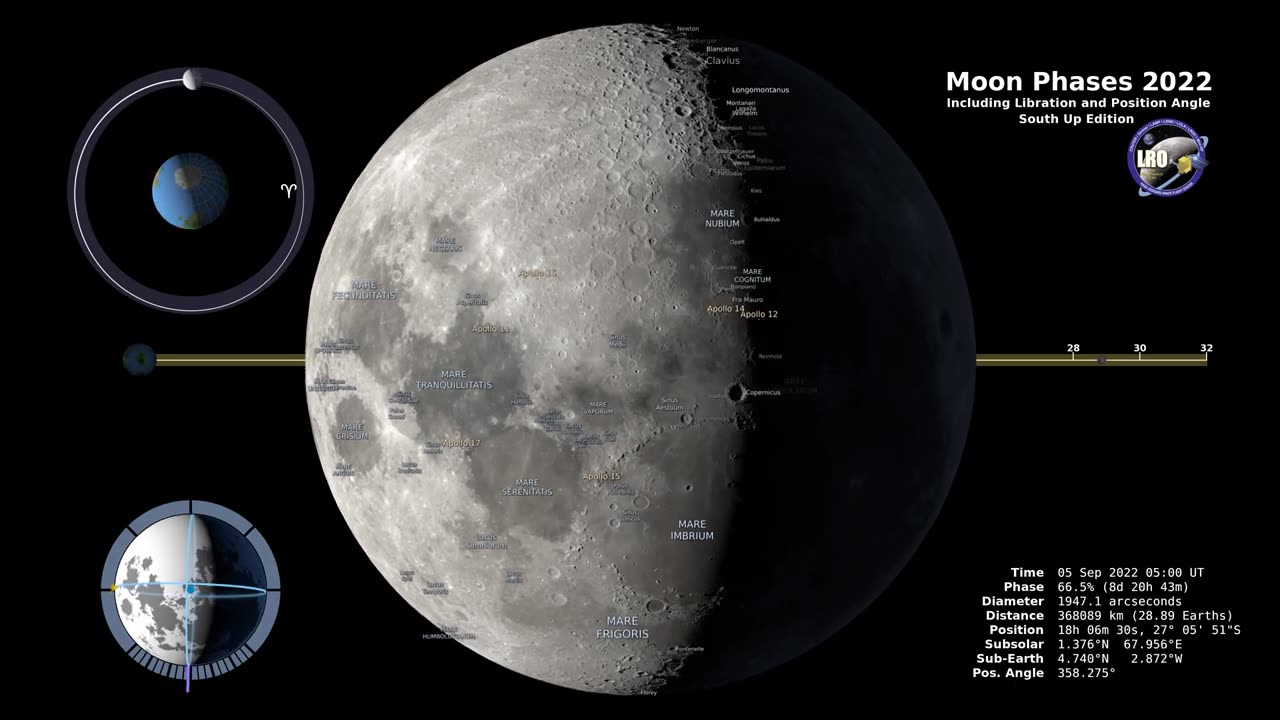Premium Only Content

NASA moon phases 2022 southern hemisphere 4K
Certainly! In the southern hemisphere, the moon phases in 2022 will follow a pattern similar to that in the northern hemisphere, but with some differences due to the perspective from the opposite side of the Earth. Here's a description of the moon phases in the southern hemisphere for 2022:
New Moon: The new moon marks the beginning of the lunar cycle. During this phase, the moon is positioned between the Earth and the sun, with its dark side facing Earth. As seen from the southern hemisphere, the illuminated side of the moon is facing away, resulting in a moon that is not visible.
Waxing Crescent: As the moon orbits the Earth, a small sliver of illuminated crescent becomes visible. This phase, known as the waxing crescent, follows the new moon. It is visible in the western sky after sunset and appears to grow larger as the days progress.
First Quarter: About a week after the new moon, the moon reaches its first quarter phase. From the southern hemisphere, this phase reveals the right half of the moon illuminated. It's often seen in the evening sky, and its position in the sky is lower than what is observed in the northern hemisphere.
Waxing Gibbous: The waxing gibbous phase occurs as the illuminated portion of the moon continues to expand. From the southern hemisphere, the moon's shape appears to be filling out on the right side.
Full Moon: The full moon occurs when the entire side of the moon facing Earth is fully illuminated by the sun. From the southern hemisphere, the full moon is visible high in the northern sky. It's a bright and captivating sight.
Waning Gibbous: After the full moon, the moon enters the waning phase. The illuminated portion gradually decreases, starting with the left side. The waning gibbous phase presents a moon that is still fairly bright but is decreasing in illumination.
Last Quarter: Around a week after the full moon, the moon reaches its last quarter phase. This phase reveals the left half of the moon illuminated when observed from the southern hemisphere. It's often seen in the morning sky, relatively high in the northern sky.
Waning Crescent: As the moon approaches the end of its cycle, the waning crescent phase emerges. The crescent shape becomes thinner and thinner, and it's visible in the eastern sky before sunrise.
Throughout the year, these moon phases will repeat in a predictable pattern as the moon completes its orbit around the Earth. The specific visibility and appearance of each phase can be influenced by factors such as your location, atmospheric conditions, and local light pollution.
-
 LIVE
LIVE
TimcastIRL
2 hours agoUNHINGED Liberals PROTEST Colbert Cancellation In NYC, Propaganda Machine IS COOKED | Timcast IRL
27,295 watching -
 LIVE
LIVE
The Quartering
1 hour agoToday's News Chat & Act 2 Of Expedition 33
597 watching -
 LIVE
LIVE
SpartakusLIVE
3 hours agoMonday MOTIVATION || Games w/ the BOYS into the NIGHT
522 watching -
 LIVE
LIVE
Barry Cunningham
2 hours agoNEWS ON THE PLOT AGAINST THE PRESIDENT AND IT'S A MOVIE NIGHT!
7,829 watching -
 2:00:32
2:00:32
Glenn Greenwald
5 hours agoWorld Finally Horrified by Israel's Atrocities in Gaza; Mass Starvation Expert Warns of Spiraling Crisis in Gaza; AOC Votes to Fund Israel's Iron Dome | SYSTEM UPDATE #489
43.9K42 -
 LIVE
LIVE
Gurk
32 minutes agoMLB CO OP
18 watching -
 UPCOMING
UPCOMING
Adam Does Movies
3 hours agoTalking Movies + Ask Me Anything - LIVE
111 -
 1:46:27
1:46:27
Tim Pool
8 hours agoSin Frontera: The End of Illegal Immigration (DOCUMENTARY PREMIERE - 6pm EST)
174K53 -
 LIVE
LIVE
VapinGamers
1 hour agoDestiny 2 - Edge of Fate Legendary Run and AD Testing RTMP Pass Thru - !rumbot !music
75 watching -
 LIVE
LIVE
Joker Effect
52 minutes agoULTRA MEGA STREAM! Let's review things... Also... Joker was right... again! What a surprise :) Also.. what the heck is @NetAxisGroup ?
484 watching